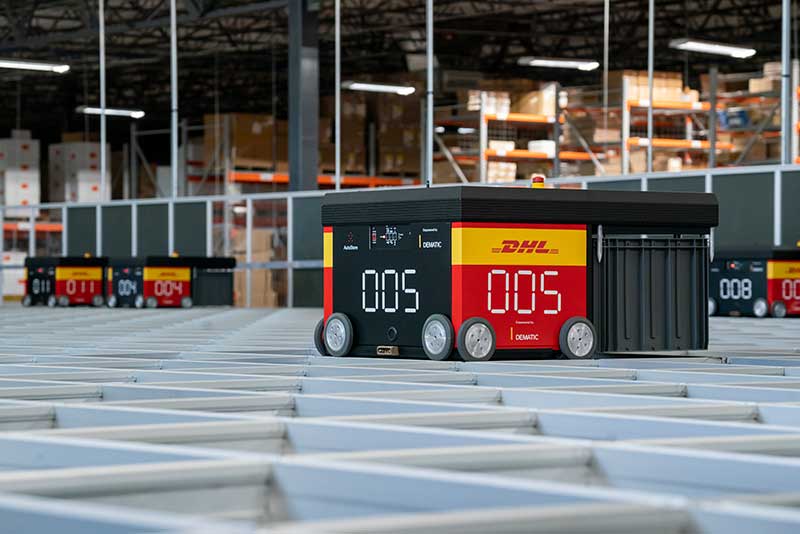Three Key Questions: How to know if you’re ready for goods-to-person technology
If you’re considering a goods-to-person deployment, we provide three questions you’ll need to answer.
Goods-to-person systems are increasingly displacing person-to-goods picking based on the value they deliver. In addition to an up to 5x increase in productivity, these systems support faster order cycle times, improved accuracy, and increased storage density.
But the move to goods-to-person picking represents a fundamental shift in warehouse operations and requires careful planning to ensure the value of the system can be maximized and disruptions caused by the transition can be minimized. At DHL Supply Chain, we are using goods-to-person technology across multiple sectors of our business and have standardized and refined processes for selecting, configuring, installing and managing goods-to-person systems. If you’re considering a goods-to-person deployment, here are three questions you’ll need to answer.
1.) Is goods-to-person technology required for this application
Goods-to-person technologies are a proven approach to reducing labor requirements and increasing picking speeds, but they aren’t the only approach. They deliver higher productivity than alternate approaches, but also typically have longer deployment times. Not only is the timeline for system configuration and installation longer, but products stored on racking have to be consolidated or moved to another location prior to the installation, potentially impacting service levels during the deployment. With typical deployment times of one year or more, most organizations will have to manage through at least one peak season amid the disruption created by the installation.
If you’re moving into a new warehouse, whether operated by internal resources or a 3PL, this shouldn’t be an issue. If you plan properly, you can continue serving customers from your existing facility while automation is being implemented in the new facility.
If you’re seeking to automate an existing facility and are reluctant to embrace the degree of change represented by goods-to-person picking, robot-assisted picking can be a viable alternative. These systems work with existing racking systems to increase productivity by transporting products picked by humans in the aisle to packaging. While they can’t match the productivity levels of goods-to-person systems, they enable significant gains over current manual processes and can usually be deployed faster and with less disruption.
2.) What goods-to-person system is right for this application?
If goods-to-person picking is right for your business, there are multiple technologies to consider. Autonomous mobile robots, shuttle systems and cube-based storage systems all support goods-to-person picking and each has strengths and weaknesses that should be considered in the technology selection process.
Mobile robots that deliver shelves or totes to stationary pickers, for example, don’t offer the storage density of other approaches, but can typically be implemented faster than those systems and can be a good solution for applications that aren’t seeking to maximize density.
Shuttle and cube-based systems are fixed systems that deliver high throughput and enhanced storage density but require longer deployment times than mobile robots.
Shuttles are a good choice when high throughput is a priority. These systems can also offer more flexibility in the types of products they support than cube-based systems, storing and retrieving products in bins, trays and cartons. They do, however, have higher maintenance requirements than cube-based systems.
Cube-based systems offer the highest storage density of the approaches mentioned here, so are a good choice for sites supporting a high number of SKUs. But because they achieve their density by stacking bins vertically within the cube-based design, they only support products that fit within the bins. Their design does allow configuration around pillars and in irregular shapes to maximize space utilization. They are also low maintenance and maintain access to all inventory if a robot is taken offline.
Each of these approaches can deliver significant improvements in the speed and productivity of item picking operations, especially when the technology is matched to the density, throughput, and inventory requirements of the site.
3.) How will the system integrate with our operations?
Regardless of which technology you choose, warehouse processes will need to be re-engineered to support the goods-to-person material flow, including coordinating automation with manual picking. In most applications, some products will continue to be picked manually either because they don’t fit within the automation system or can be picked more efficiently via dedicated high-volume pick locations.
As a result, you’ll need to implement order consolidation processes prior to packaging and shipping. You’ll also need decanting processes for maintaining proper inventory levels within the automation system.
Picking processes can be optimized through proper design of the “pick stations” in a goods-to-person system. Tailoring the pick station to your products and fulfillment processes and applying ergonomics contributes to both productivity and comfort.
The other thing to pay attention to is the integration between the automation control system and the systems currently used to manage inventory and orders. While processes for installing the physical hardware are well-defined, the process for integrating automation software with warehouse systems must be tailored to your systems, products and processes. Poorly executed software integration is a common cause of project delays. Operations and IT teams need to work closely with the automation provider throughout this process to ensure the automation control software is sending and receiving the right information at the right time in the right format.
Mitigating Risk, Maximizing Value
Goods-to-person technologies have revolutionized item picking by enabling faster speeds and reducing dependence on hard-to-find labor. But the time and resources required to select, implement and manage these technologies should not be underestimated. The last thing you need is a delayed startup or a system that isn’t meeting expectations as you approach a peak season.
DHL Supply Chain has developed expertise with various goods-to-person technologies and can take the risk out of the transition while maximizing the benefits. From shuttles to cube-based AS/RS to mobile robots, we are operating goods-to-person automation systems across our network that are improving speed, productivity, and accuracy.
For more information, visit www.dhl.com/allin.













